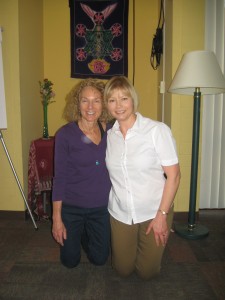
Amy Weintraub and Lonnie Jan 19 2013
I have completed LifeForce Yoga® Level I training and am incredibly excited to be able to integrate and offer this profound system to my students and private clients. This yoga is meant to help manage mood, but it is much more than that. Frankly, I don’t think there is any one who cannot benefit from this style of yoga.
So what, exactly, is it?
Quoting excerpts, and paraphrasing, Amy Weintraub in her LFYP-1 training manual:
“LifeForce Yoga® is Yoga plain and simple. It doesn‘t really need a name, but in this day and age, when there are so many ways of practicing that are called Yoga, it‘s important to identify a practice that is intentionally designed to work with and manage the mood. The many styles of Yoga practice that are flowering in the West are like doorways. Eventually, each door opens the practitioner to a deeper connection to Self, an awakening to the felt sense that we are not separate. Yoga, no matter what lineage you have trained in or style you practice, begins as you practice regularly, to unite the
polarities within and without. The sense of separation, which is the literal source of depression, is diminished and the sense of connection to oneself and others is enhanced.” (italics and bold added)
“Among the many doorways to Yoga or union that exist in the West, some focus on fitness and strength, which is the literal meaning of ―Hatha—physical force. Others focus on structural therapeutics”. Other doorways take as their mission to raise energy, or to reach some spiritual goal. “But reaching implies absence.” LifeForce Yoga understands that there is no separation, that we are intimately, eternally connected. “LifeForce Yoga is practiced as the first yogis practiced, resting on the fundamental belief that all that we need is already within us; that beneath the current mood, the roles we play and the masks we wear, we are the wholeness we seek.”
“To make it simple, LifeForce Yoga is a practice of compassion that creates a big enough container to embrace and accept all the dualities of mood. The practice is adapted to the student, so each individual can move into a more balanced (sattvic) and positive emotional, mental, and physical state of equanimity and self-awareness.” In a LifeForce Yoga session, you will move slowly, and each practice and effect will be chosen and observed with you in mind. You will be taught strategies that clear the temporary obstructions and that empower you to access your own true nature. You will be encouraged to remember that you have, within you, the tools to heal and to sustain that healing with regular practice.
“The practice may include a Yoga mat, when appropriate, or it may be a compendium of practices drawn from the broader field of Yoga science that existed for thousands of years prior to the British introduction of physical culture in the 19th century.”
In an atmosphere of acceptance and love, you can learn the tools to clear your own inner space of whatever is preventing you from realizing and sustaining your optimum mental health.
These Yogic tools include:
- Asana (posture)
- Pranayama & Kriya (breath and cleansing ritual)
- Mantra (sound)
- Bhavana (visualization)
- Sankalpa (intention)
- Mudra (hand positions)
- Meditation
- Yoga Nidra (a form of guided relaxation; relaxed awareness)
- Therapeutic Long holding of posture
- Non-dual Strategies for working with negative self-talk
“LifeForce Yoga® as differentiated from exercise:
- Attention to the breath
- Safe attention to body sensations
- Cultivation of both compassionate equanimity and self-awareness (2 pillar of yogic practice and goals of psychotherapy)
- Cultivation of witnessing consciousness (in neuropsychological terms, engaging the cerebral cortex in self-regulating the emotion”
“Physiological benefits of Yoga practice:
- Decrease in cortisol levels
- Likely increase in feel-good hormones: oxcytocin and prolactin
- Increased serotonin
- Demonstrated improvement in memory, cognitive functioning, perceptual motor skills, visual perception
- Relaxes chronic muscle tension
- Restores natural diaphragmatic breathing
- Improves oxygen absorption and carbon dioxide elimination
- Increases alpha and theta waves
- Regulates hypothalamus at an optimum level
- Certain techniques stimulate vagus nerve activity
- Bioavailability of oxygen and glucose, building blocks for the production of neurotransmitters
- Calms sympathetic nervous system while activating parasympathetic system
- Increase in GABA levels
- Increase in Heart Rate Variability (HRV)”
“Psychological effects of Yoga practice:
- Elevation of mood
- Balances left/right brain function
- Cultivates equanimity in the face of life‘s challenges
- Develops greater self-awareness
- Symptoms of depression are lessened
- Better management of bipolar disorder
- Greater access to feelings, which is a complement to talk therapy
- Release of repressed emotions stored in the body
- Increased ability to self-regulate”
It may be that you already have found a yoga practice that supports your emotional well-being — that meets your current mood and constitution and moves you into balance. Or you may have chosen a practice that exacerbates your already over-driven propensities. Often we choose what we like, not what is good for us at a given time. And a style that is focused on perfection may activate the stress response and provoke ripples of shame. LifeForce Yoga specifically aims to balance the nervous system and emotional body.
Be ground. Be crumbled, so wildflowers will come up
Where you are. You’ve been
Stony for too many years.
Try something different. Surrender.Rumi